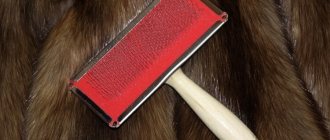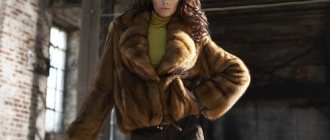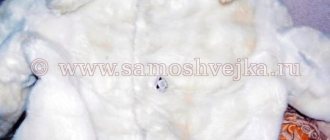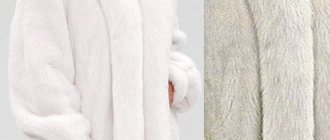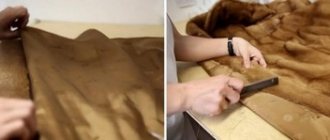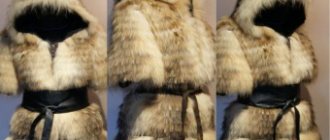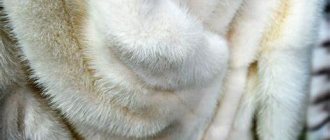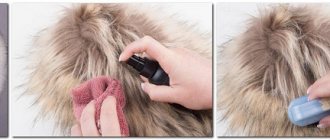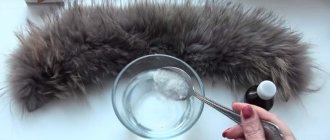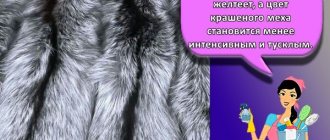Many people have heard about sheared fur coats made from various furs. Sheared fur has long been in fashion and such coats are offered at fur fairs and in stores. Fur coats made from sheared mink, sheared beaver, nutria - there are types of fur offered for every taste.
And many people wonder: is it possible to cut a fur coat at home, and how to do it?
In principle, this is real.
Even if you are not an experienced furrier, you will be able to trim a fur coat, but there are several nuances that must be taken into account if you do not want to ruin the fur.
Also, do not forget that the first experience may be unsuccessful, so do not take unnecessary risks with a new good, especially expensive, thing.
How to trim fur?
You should not cut a new fur coat if you have not worked with fur before and have never cut fur. It’s better to experiment on old fur coats and short fur coats, which, if something happens, you won’t mind.
Before cutting, the fur coat must be cleaned and long guard hairs removed.
The most important point: the fur should be spread out as much as possible on a hard surface. That is why you should not cut the fur coat as a whole; in order to trim the fur as efficiently as possible, you will have to tear it apart.
To do this, first open the lining and undo all the seams that prevent the fur coat from lying flat on the floor. If you are not sure that you will be able to sew your fur coat back together after cutting it, then cut it without ripping it apart, but by hanging it on hangers.
The fur coat is cut using a regular hair clipper, which many people have in their homes. It comes with attachments that cut at different heights. The knives must be sharp; adjust the clipper in advance and make sure that it cuts well and does not pull out the fur when cutting.
To start, use the highest comb to avoid cutting off too much fur. Cut the fur coat from top to bottom, cut evenly throughout the fur coat, try to achieve the most even and velvety surface. Take your time, cutting a fur coat takes a lot of time and requires care and perseverance.
Low attachments for the machine allow you to cut patterns on a fur coat, but it is not advisable to do this yourself - there is a risk of damaging the fur.
After the fur coat is trimmed, shake it out thoroughly and vacuum it to remove the trimmed fur. After this, assemble the fur coat and sew on the lining.
Happy experimenting with style!
Nutria are bred for valuable and high-quality fur. The cost of each skin ranges from 250 to 2500 rubles. This difference is due to the size of the skin, the color of the fur and the quality of the dressing.
Dressing nutria skins at home is not the easiest task, but having mastered it, you can increase the profitability of breeding aquatic rodents.
Preparing for self-restoration
Having decided to start restoring a fur coat, you need to go through all the stages of preparation so as not to completely ruin the product. The first thing you need to do is take your fur coat out onto the balcony or into the yard and ventilate it well. Next, you should clean the fur, getting rid of possible seasonal dirt. You cannot do this with your own hands; in inexperienced hands the product will shrink, become distorted and be irretrievably lost.
And only after the clothes are ready to wear, you can cut them, but first carefully peel off the lining with very sharp nail scissors. Care must be taken not to touch the flesh with a careless movement. Before starting a haircut, prepare the following tools:
- long thread;
- needles;
- a regular machine designed for cutting hair;
- attachments for it;
- brush with metal teeth;
- tweezers.
Additionally, a large piece of oilcloth should be included with them. This will make it easier to remove clipped fur, which is difficult to get rid of even with a vacuum cleaner.
Stages in tanning hides
Degreasing
Before processing the skin of an animal, the workpiece must be degreased in order to remove any remaining meat, fat deposits, and blood from the flesh. If you skip degreasing, the leather will lose elasticity, become brittle and brittle, and not suitable for dressing. And a product made from such skin will become unwearable very quickly.
Washing and unwinding
After degreasing, the workpiece must be thoroughly rinsed to remove chemicals and traces of blood and fat. The unwinding process resembles canning and is carried out in a saline solution or in a solution of special antiseptics. After proper washing and unwinding, the skin acquires the necessary steamed state, which can be easily determined by sufficient water content and the restored properties of the elements of the dermis.
Pickling and laying
The most important step is pickling or pickling. The subsequent ductility and elasticity of the skin depends on it. Most often, table salt and one of the organic acids are used for pickling. After pickling, the skin must be cured. For curing, the workpiece is removed from the pickle solution, wrung out, rolled up so that the flesh is inside and left for at least ten hours.
Tanning and fatliquoring
After fermentation comes the turn of tanning. The process is necessary to consolidate the effect of separating leather fibers, as well as to make the workpiece more resistant to external factors: heat, humidity, various enzymes and chemicals. Most often, tanning occurs in a solution containing chromium salts. Fatliquoring is carried out after tanning and a variety of compositions are used for it. However, each of them must contain fat of animal origin. Most often they use pork or lamb fat, but some tanners prefer to work with fish and even bone fat.
Storage after fattening should take at least eighteen hours.
Breakdown and fleshing
Before you start stripping the leather, a breakdown is necessary. It is at this stage that the curing of the skin as such ends. The subsequent stages are more mechanical. The purpose of breaking is to process the flesh until it is soft and elastic. After all the chemical solutions, the leather fibers became pliable, but retained their strength. Breaking involves repeatedly pulling the skin with very sharp bending through a thin yard, a board, a blunt braid, a metal bracket or fitting, or a clothesline. The thinner the item, the better. If the breakdown was carried out correctly, the flesh becomes whitish-cream in color, and the fur becomes shiny and fluffy.
Methods of dressing skins
The easiest way
The first method of dressing nutria skins looks like this: the skin is placed in a bath for an hour to soak at a water temperature not exceeding +38 degrees. To wash away fat and subcutaneous films, you can use any available detergent - three grams for every liter of water. After this, the workpiece must be thoroughly rinsed and washed in running warm water. For subsequent rewinding, prepare a solution in advance according to the recipe: a liter of warm water and twenty grams of salt. The nutria skin is placed in this composition for 15 - 17 hours. Then the workpiece is filled with pickel solution for another 10 - 12 hours.
The pickle solution is prepared according to a simple recipe:
- Liter of water,
- Sixty-five grams of table salt,
- Twelve grams of acetic acid.
Determining the end of the pickling process is quite simple - just bend the wet skin of the animal and squeeze it with your fingers. If an even white stripe has formed at the bend, you can remove the workpiece and send it to rest for a day or more.
To trim nutria skins, the tanning stage is given at least ten hours and a solution of chromic oxide with the addition of table salt and hyposulfite is used. During the entire tanning period, it is necessary to maintain a constant solution temperature of 35 degrees. Next is the turn of fatliquoring, for which an emulsion is prepared in advance. For one liter of emulsion or fat paste you need:
- About 200 grams of soap (the most ordinary household soap will do),
- 85 grams of any animal fat,
- 7 - 10 ml of ammonia.
The prepared paste is carefully applied to the flesh with a small brush so as not to touch the fur. The fatliquoring stage cannot be called mandatory, but after it the skins of the animals acquire greater elasticity and softness. After treatment with the emulsion, the skin is hung out to dry for 10 - 12 hours in a well-ventilated area, after which the skin and hair are cleaned of possible traces of the solution and other contaminants.
The skin prepared in this way can be sold at a profit, and products made from it will be durable, durable and will have a bright shine of fur.
Accelerated skinning
You can repair the skin of a swamp beaver in less time. Accelerated technology involves reducing the exposure time in tanning solution, which is made on the basis of formaldehyde. The preliminary stage consists of removing fat and meat residues from the skin in sufficiently salty water, and then washing the workpiece with washing powder. While the skin is drying on a flat surface, you need to prepare a solution of water (a liter is enough for the skin) and thirty grams of salt. The workpiece is left in the resulting solution for another half hour.
After a set time, formaldehyde and a gram of soda ash are added little by little. There is one important rule for adding formalin: the drug is injected into the saline solution twice, two milliliters every half hour. The resulting mixture is thoroughly mixed and left for six to eight hours. Next, you need to carefully pour in fifteen milliliters of acetic acid. And after another eight hours - four milliliters of ammonia. The solution along with the skin is constantly mixed for an hour.
After the allotted time, the workpiece is removed, squeezed out and sent for fatliquoring. For this process, using an accelerated method, use a paste made from a liter of water, a quarter of a bar of soap (it is better to choose soap that contains as few aromatic additives as possible), half a liter of animal fat (lamb fat is most often used, but it is preferable to use bone fat), half a liter of spindle oil and twenty-five grams of ammonia. The fat emulsion is carefully applied to the skin without touching the fur. Next, the workpiece is dried, kneaded, the core is sanded to the desired degree of softness, and the fur is combed out to remove any possible contamination.
Possibility of coloring the ridge by “guidance”
Using the same brush or spray bottle, the skin can be painted from nose to tail without affecting the rest of the fur. The width of the painted stripe is adjusted by the speed of spraying the paint from the center of the ridge to its edge.
“Hovering” adds tint, so this process should not be confused with bleaching. When bleaching the skin along the ridge, it is possible to add gold or silver paint.
Cutaneous defects of spring skins are also well masked by “guiding” with bleaching. Yellow and red shades (in colored and dark mink, respectively) can be corrected by bleaching.
Nepov method
This method is also called fresh-dry dressing.
The initial processing of the workpiece is carried out in a solution of fifty grams of ordinary table salt and a liter of water, as well as ten grams of sodium silicate. Primary processing time is about eight hours. Next, the flesh should be thoroughly cleaned of possible fat or meat residues, subcutaneous films and other contaminants. After cleaning, the nutria skin is placed for degreasing in a soap solution with the addition of soda for five hours. Next, the skin is removed, rinsed in running water, wrung out several times and placed in a pickle solution. For fresh-dry pickling, a pickle solution is prepared from water, any available organic acid and table salt.
After a day, the skin is transferred to the tanning mixture. It is better to use a mixture of salt and chrome-potassium alum. Per liter of water you need about 85 grams of salt and no more than 5 grams of double metal salts. On average, tanning using this method takes about 10 hours. Next, the skin is rinsed and left to dry.
The final stage is fattening. For it, you need to make a paste from 85 grams of any available fat of animal origin, 200 grams of soap without aromatic fragrances, a liter of water and 10 grams of ammonia. The paste is applied to the workpiece with a brush or a brush, but so that the composition does not get on the fur, but completely covers the inside. Drying after degreasing takes no more than eight hours, after which the fur is cleaned with a brush to remove any possible dirt, and also moistened with alcohol to give it a more pronounced shine.
Skins can be processed in this way not only for outerwear, but also for accessories, as well as for interior use.
Fur trimming
The dressing of nutria skin involves not only the processing of the inner skin, but also a possible haircut. Sheared fur looks more expensive, more original, and sometimes tanned sheared skins cost several times more than ordinary ones. Fur trimming is a special treatment of the hair of an animal’s skin to give the future product more structure. Sheared nutria fur resembles in its structure more expensive mink fur.
Those who have already donated fur know that there are several types of fur cutting. The simplest option is a simple uniform haircut. The height of the fur is the same. A more complex and more expensive option is a curly haircut. A variety of designs and patterns allow you to create very beautiful models of complex cut. A curly haircut is limited only by a person’s capabilities and imagination.
But sometimes trimming a nutria's fur is simply necessary. The procedure is required:
- In case of detection of fur defects.
- If the nutria was old and the guard hairs were too coarse and brittle.
- In case the guard hairs are too pronounced, which reduces the price of the entire skin.
Fur cutting process
How to trim nutria fur at home? If there is little experience in such processing, then the process should be carried out very slowly and carefully. Before shearing, the skin is spread out on a flat and fairly even surface, and the fur is cut with an ordinary clipper. When choosing a model, you should pay attention to the availability of various attachments, and give preference to animal clippers. Users noticed that the machine for humans in most cases did not trim the nutria fur evenly, plucked hairs, leaving scraps of long fur and visible bald patches, and the knives quickly became unusable. When cutting, it is important to pay attention to uniform pressure, but there is no difference in how to cut - according to hair growth or against it. After shearing, the fur piece must be shaken and combed well.
Stencil painting
To apply a design to the skin, stencils made of paper can be used. They are painted in one or two colors, less often in three.
Products with plucked and sheared fur became popular, double-sided models sold well, and, in response to demand, such areas as silk-screen printing and chemical stencil painting began to develop.
Plucked and stencil-dyed fur is beautiful in its own right, and this has increased the consumption of wild furs, which were previously considered inexpensive. For example, the skins of squirrel (as an option - weasel), badger, ermine. The semi-finished fur product is collected into large plates, about a meter in size, then goes through the process of dressing and pinching to make it possible to apply various patterns to the assembled skins.
Reveal the fur
If you plan to sew a fur product at home, it is necessary to know about the features of cutting skins and the correct selection of fur. In order to sew a product you need to have a special furrier's machine, otherwise you will have to work manually. A regular sewing machine will make the seam weak and too stretched, and the leather fabric will tear easily. Correct selection of skins involves selection based on fur color and thickness, hair length, shade and size. There are two technologies for cutting skins - simple and complex, each of which includes several methods.
Simple ones include:
- Cutting according to an existing pattern.
- Cut the nutria skin according to the finished template.
- Trim some parts of the animal's skin located close to each other for a more convenient connection.
Simple methods are used for sewing coats and hats, which do not require additional manipulations with fur or workpiece. If, to sew a product, it is necessary to completely or partially change the shape of the nutria skin, its length, as well as the width, density and direction of the fur, or if sheared skins are used, then complex methods are used. These include: breakdown and soldering, precipitation. transfer and jointing, dissolution. Each of these methods is quite complex and labor-intensive, and only experienced furriers can work with them, otherwise there is a high risk of ruining the animal’s skin.
Probably every owner of a fur coat has encountered a situation where, after wearing it for several seasons, the fur on the collar, cuffs and near the pockets of the product has become frayed. In this case, there are 2 options to solve this problem. The first option is to buy another fur coat. However, it is not suitable for everyone, since most of the fair sex purchase such things for more than one year. In addition, the rather high cost of a mink coat does not allow a number of women to purchase this wardrobe item on their own. Therefore, the 2nd option remains - restoration of the product. So, to protect frayed areas, you can sew small strips of leather on them, but they can ruin the appearance of the product and make the interior more fragile. If this restoration method is not suitable, you can trim the fur. Procedure 1. Prepare the product for cutting. To remove the lining from a fur coat, you should use a seam ripper, which will help not damage the interior. Next you need to deal with the fur. We carefully straighten all the folds, clean the fur coat with a wire brush and send it to the balcony to air out. If your fur coat is heavily soiled, it should be dry cleaned. After completing all these procedures, lay an oilcloth on the floor and lay out the fur coat with the pile facing up. After this, using tweezers, very carefully pluck out the guard villi. This is necessary so that the fur retains its softness after shearing. 2. Prepare the tool. We take a hair clipper. Her knives should be sharp, as they will help remove fur evenly and quickly. It is also necessary to pay attention to the power of this device. The higher it is, the easier the cutting process will be. Then you need to decide on the height of the pile and choose a suitable nozzle. 3. Trim the fur. You should start cutting from the bottom up, against the direction of the pile. This way the fur will be smooth and velvety. After removing the first layer, it is necessary to change the nozzle to a similar one, but with greater depth. Then you need to measure the distance from the bottom edge of the product - the width of this nozzle. For greater accuracy, you can use a ruler or thread pre-attached to needles. After applying the markings, you can begin. To begin, cut a horizontal strip parallel to the bottom edge of the fur coat. To go higher, we make markings again and cut the next row. The sleeves are cut separately. The result should be smooth transverse stripes, similar to corduroy. 4. Assembling the fur product. After the haircut is finished, the lining is sewn into place, the fur on the fur coat should be carefully combed with a brush with metal teeth - this will remove small fibers. That's all, the fur coat is ready!
Natural, soft fur that shimmers in the sun is a sign of sophistication, refined taste and luxury. Fur products are unlikely to ever go out of fashion, and advanced manufacturing technologies make it possible to create exquisite, warm and practical fur products of the highest quality. It is precisely these fur coats that the fur factory “Lynx” is famous for, which has inherited the best Russian traditions in the production of fur products.
The basic strategy of the factory is to provide a wide range of services to its customers, with consistently high quality of delivery. For example, shearing skins
- the process is painstaking, and requires not only good equipment, but also the experienced hands of a craftsman.
At the Lynx factory, fur shearing
is carried out using special machines of the latest generation. Today at the factory we use computer-controlled equipment, so there are no errors or failures in our work.
Choice
Today, thanks to the large selection of astragan fur coats, they are becoming more popular. Women who have already experienced the uniqueness and warmth of this fur began to pay attention to the various models of cropped mouton fur coats. Having chosen such a fur coat, fashionistas do not regret it, as they look very majestic in it.
Some girls know little about this practical material. Therefore, before purchasing, it is better to review information about the cropped mouton. This information can be easily found on the Internet. It turns out that this is the same sheepskin that has undergone additional processing, as a result of which it has become unusual and much more pleasant.
Please note that the original models of astragan fur coats look great on the figure, and the fur is distinguished by its shine and chic, according to reviews. Modern technology for processing this fur has led to a revolution in the global fur market. This type of mouton has an unusual appearance.
To produce a sheared mouton, a uniform haircut is usually used. But there are exclusive models in which the fur plays with unusual patterns. If you come across such a luxurious model made of sheared mouton with silver fox on sale, be sure to buy it for yourself.
Cost of fur cutting
There is no shearing of fur products, only whole skins.
There are many types of fur haircuts - traditional, curly, laser (burning) and even lace (perforated). Using laser burning, you can create absolutely any pattern on fur, without losing any of its properties.
Mainly beaver skins are cut
and today the most in demand and popular service is traditional
beaver fur trimming
.
Beaver fur itself is very warm, wear-resistant and inexpensive, however, its long hairs are a little harsh. If you don’t know how to cut a beaver fur coat
, then our specialists will tell you what type of haircut is best suited for your product.
Therefore, if you are wondering where to get a beaver coat cut
efficiently and beautifully, then the answer is clear - contact us.
The Lynx factory will provide the following services in this direction:
- Beaver fur trimming;
- Mink fur trimming;
Every woman has or dreams of having a fur item in her wardrobe. Most often, preference is given to nutria fur, due to its properties and excellent qualities. Natural skin can be of different colors, and the cost of the fur product even depends on this.
What they don't talk about
Plucked fur also appears as a result of an attempt to give a skin that has defects in the growth of guard hairs a marketable appearance. As a result of pinching, low-quality raw materials have a chance to move to a higher category. The difference between high-quality and low-quality material is smoothed out. The plucked fur of some animals that have inexpensive skins is very similar to the fur of fairly expensive types of fur-bearing animals. For example, nutria fur, when plucked, perfectly imitates mink fur. Therefore, by combining plucking and coloring of nutria fur, you can get a skin that is exactly like mink skin.
Properties
It largely depends on the conditions in which the animal grew up. But even regardless of this, the products turn out to be warm, wear-resistant and, most importantly, beautiful. Ragontine fur is thick, delicate and shiny. The thickness of the layer can be changed using a special stretcher.
The skins of animals that grew up in natural conditions are more valuable, however, it has a significant drawback - it has to be artificially dyed, since the original color is unattractive. Nutria bred artificially can have a wide variety of colors - from soft white to black.
It can be cut or not cut. It’s simply impossible to say which is better; the main difference here is the appearance. Plucked and shorn looks much more attractive; it is often used to imitate mink fur products, which are much more expensive. Untreated nutria skin can be distinguished from mink even with the naked eye. The fact is that ragontine skin has three categories of hair, while mink has eight.
Characteristic:
- wear resistance (8 seasons, 45-60%);
- moisture resistant;
- soft but elastic undercoat;
- characteristic strong shine;
- availability.
Important! Compared to other furs, nutria is considered the most accessible and inexpensive. Among the huge range of offers, every fashionista can easily choose an option that will best satisfy all requirements and will not hit the wallet. You can choose both more expensive options and more budget ones, everything will depend on the type of fur, features and processing.
Advantages
- Clothes made from astragan weigh much less than fur coats made from ordinary mouton;
- Thanks to the haircut, the mouton acquires a unique, fascinating texture of fur;
- As a result of cutting, the mouton's pile becomes short, but the undercoat remains dense and warm;
- Products with a hood made of cropped mouton have a long service life. If you follow the storage rules, such a fur coat will always have a fresh look and will look like a new thing;
- Clothing made from astragan is resistant to any weather and can withstand different temperatures;
- The fur coat, thanks to the combination of such qualities as practicality, elegance and low cost, has become very popular among many women;
- Even overweight women can wear winter clothing made from astragan, as it does not make them look fat;
- The sheared mouton is a beautiful fur, and it is perfectly complemented by such furs as mink, sable, and silver fox.
Price and quality
Sometimes, a woman chooses clothes made of expensive fur, thinking that it will be the one that can warm her in the cold winter, as well as give her owner a special charm and style, as in the photo. Beautiful products made from sheared mouton refute such opinions. Not only are they very warm, but they won't completely empty your wallet.
At the same time, you can complement your wonderful look with beautiful boots and a fashionable handbag. The low cost of such a fur coat will greatly please fashionistas. If you have the opportunity, then go to a fashion boutique where you can choose a designer model made in an individual style.
It was the low prices that influenced the popularity of astragan products, which became accessible to fashionistas of any age. The fur coat has one drawback - it's weight, which you just get used to and wear it with pleasure. It is worth noting that specialists are developing new technologies that make products much lighter. Newer fur treatments are also emerging that can change the color and cut of the fur.
Today you can already buy a lightweight mouton with an original texture and shiny pile. A fur coat made from a sheared mouton looks expensive and elite.
Our store gives women the opportunity to decorate their wardrobe with a natural mouton fur coat. Inexpensive models made of sheared fur will be a great purchase! You can find out the features of caring for such clothes and get advice on choosing a style and size by calling.
Stylish fur coats made from sheared mouton have many advantages. They are light, incredibly soft to the touch and have a noble shine. Special processing of the skins makes the material look like sheared mink fur. It is sometimes difficult for a non-professional to distinguish them from each other. A mouton product can be worn for up to 8 seasons and provide comfort to its owner at temperatures of about -15 degrees. At the same time, the cost of such fur coats is very attractive.
Warm or not
When purchasing a product, many people wonder: is nutria fur warm or not? Nutria fur coats are great for winters with harsh climates. It is not exposed to moisture, it is wear-resistant.
Snow and rain, high humidity, severe frosts and strong winds - all these unfavorable weather conditions can be easily overcome with a high-quality fur product made from ragontine. If you compare it with other products, then, for example, a beaver fur coat will be warmer, but it will also cost more.
Products made from this type of fur do not require careful and complex care. Even if you regularly get caught in snow and rain while wearing a fur coat, it is enough to just vigorously shake the product several times when you arrive home and dry it at room temperature.
Many people are interested in the question, why does fur cough? This happens due to improper care. Please remember that the product should only be stored in a dry and clean condition.
Any dirt can be easily removed from the surface of the fur, so if you want to buy a practical and wear-resistant product, it will be a priority. A fur coat made from nutria skin can last at least 5 seasons, its wear resistance is determined as a percentage - up to 65%. If we talk about other furs, then for comparison we can consider otters - 100%, mink - 70% and chinchilla no more than 40%.
Important! A product made from unplucked fur will last much longer than if the guard hair has been plucked. If you properly care for and treat a fur product with care, its service life will increase significantly.
Which to choose
The highest quality skin of individuals that grew up in wild and natural conditions. If the animals grew up in artificial conditions, all the rules were followed during their raising and a high quality of life for the ragontine was ensured, then the fur will be of sufficient quality and valued highly.
If we talk about the value of skins, then backs are chosen for expensive and high-quality products; their fur is the softest and smoothest, shiny and beautiful. For budget products, part of the legs and tails can be used. It is interesting that the fur of males is coarser and warmer than that of females, but it is practically not used for fur coats. Hats are mainly made from the fur of males.
Sheared nutria - features and disadvantages
A product of uncut nutria will last much longer than an untreated one, but it looks much less attractive. When processing the axial hair from the fur is completely removed (plucked fur), the nutria acquires a soft and velvety appearance.
The difference between sheared fur and plucked fur is that in the first case, the axial hairs are not completely removed; a frame remains, which improves the quality and wear resistance of the product. A haircut costs less than a haircut, since after the procedure you have to additionally level the undercoat.
